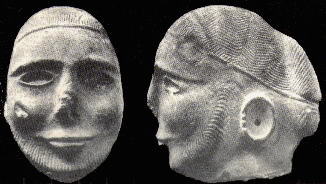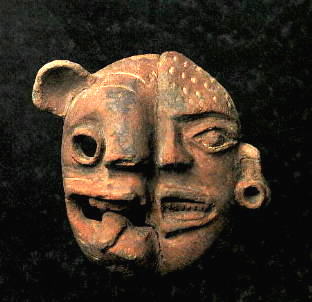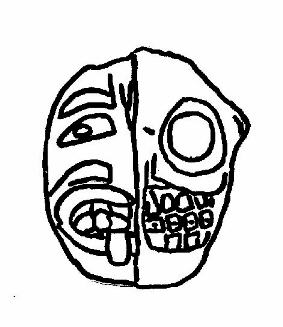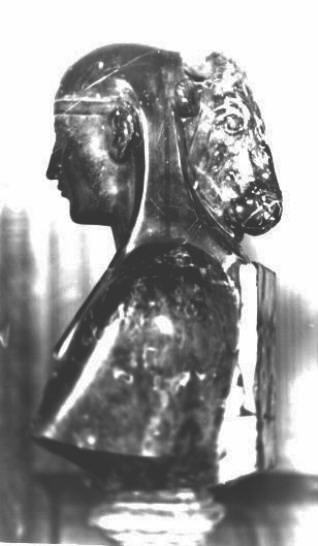Museum of the Origins of Man
HUMAN HEADS JOINED AT
THE NECK WITH ANIMAL HEADS
IN POST-PALEOLITHIC SCULPTURE

Fig. 9A1) Bicephalic zooanthropomorphic stone sculpture representing a human head (on the left) joined to the remains of a mammalian head (on the right) representing the deity gone into disuse, or it could be the head of a mammal that is covered by a headdress, for reasons we do not know, but which should be studied in depth.
The circle with the hole between the two heads is a sacred symbol, since in the area where sculptures of human heads have been found, many have the same hole on the forehead. The human head is devoid of ears, and this certainly has a precise meaning.
Size: unknown, but possibly 6 inches in height.
Origin: Mohenjo-daro, Indian region.
Third millennium BC.
 Fig. 9A2) Bicephalic zooanthropomorphic sculpture in terracotta representing half a mammal head (left) joined to half a human head (right).
Fig. 9A2) Bicephalic zooanthropomorphic sculpture in terracotta representing half a mammal head (left) joined to half a human head (right).
The mammalian head seems to be a human-animal artistic hybrid as it has the structure of a feline' s head, a partially human nose, human teeth, but the elongated tongue of a dog. The elongated tongue is present in many sculptures from Central and South America, and from Far East Asia. The human head has an earring.
Size: height 8.9 inches; width 7.8 inches.
Origin: Central Mexico. Dating: from 3rd century BC to 3rd century AD. Upper Pre-Classic period.
International Museum of Ceramics in Faenza, Italy.
Courtesy Prof. Giancarlo Bojani, director of the Museum.
For a study on this sculpture, see "Mexico's ancient zooanthropomorphic ceramics in relation to the European Paleolithic zooanthropomorphic lithic sculpture",, in in Paleolithic Art Magazine, 2000.
 Fig. 9A3) Bicephalic zooanthropomorphic sculpture in terracotta representing half a human head (left) and half a skull (right) (drawing) (see the original).. The human head is a human-animal artistic hybrid, in that it has an elongated tongue which is not a human tongue. According to Mexican scholars this sculpture is a "mask representing the life-death dualism".
Fig. 9A3) Bicephalic zooanthropomorphic sculpture in terracotta representing half a human head (left) and half a skull (right) (drawing) (see the original).. The human head is a human-animal artistic hybrid, in that it has an elongated tongue which is not a human tongue. According to Mexican scholars this sculpture is a "mask representing the life-death dualism".
Height: 3.3 inches; width: 2.8 inches.
Origin: Tlatilco, Mexico.
Middle Pre-Classic period.
 Fig. 9A4) Bicephalic zooanthropomorphic sculpture in marble representing a man, Osiris, with a bovine head attached to the nape of his neck. It is part of a pre-Christian cult that continued to exist in parallel with Christianity.
Fig. 9A4) Bicephalic zooanthropomorphic sculpture in marble representing a man, Osiris, with a bovine head attached to the nape of his neck. It is part of a pre-Christian cult that continued to exist in parallel with Christianity.
Origin: Hadrian's Villa, Serapeo del Campo, Tivoli (Rome).
Dating: 131-138 AD, Imperial Rome, second part of the reign of Hadrian.
Height: 23.6 inches approx.
Location: Rome
NEXT
Index
HOME PAGE
Page translated from Italian into English by Paris Alexander Walker.
Copyright©2020 by Museum of the Origins of Man, all rights reserved.




